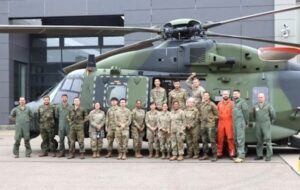
Story by Kirk Frady
Medical Readiness Command, Europe
NIEDERSTETTEN, Germany – Soldiers from U.S. Army Health Clinic (USAHC) Ansbach participated in a valuable and realistic joint training exercise with the Bundeswehr’s Transport Helicopter Regiment 30 “TAUBERFRANKEN” and German firefighters during a medical emergency response exercise in Niederstetten, Germany, June 20.
This collaborative training event provided a unique opportunity for the U.S. and German medical teams to enhance their skills and proficiency in a combined environment.
“The Bundeswehr kicked off the training event by showcasing their impressive arsenal of medical evacuation helicopters,” said Lt. Col.(P) Marlene Ariasreynoso, commander of the U.S. Army Health Clinic Ansbach. “The training was extremely realistic and beneficial to our Soldiers. The Bundeswehr team did an excellent job in performing the rescue of a wounded soldier from a simulated vehicle wreck. The scenario provided a realistic environment for showcasing the German team’s medical expertise and coordinated response efforts.”
Following the Bundeswehr’s demonstration, the U.S. Army Health Clinic Ansbach medical team put their own skills to the test. They too, simulated rescuing a casualty from an automobile crash, thus showcasing their proficiency in administering immediate medical support in a non-clinical environment.
“Their (German) techniques were a little different from ours, but just as effective,” added Ariasreynoso. “It was a great reminder that there’s always more than one way to get the job done, especially under pressure. Plus, working alongside the German team really hammered home the importance of clear communication, even with a language barrier. We all had to be on the same page in getting the simulated casualty the care he needed, and fast.”
According to senior Army medical officials, conducting tough, realistic training is the closest thing to a real-world scenario Soldiers can get outside of an actual deployment.
“Practicing casualty evacuation and trauma care with a different team in a chaotic environment is invaluable,” Ariasreynoso added. “It sharpened our skills and helped our Soldiers build confidence, working with people they might not usually have on their team. Plus, it offered them the opportunity to work in a multinational response structure – that’s huge for future deployments where they might be working with other NATO forces.”
In real-world combat and tactical situations, especially in Europe, U.S. Army Soldiers need to be able to operate together, in unison, with allied and partner nation military forces.
“This joint training event was a win-win for everyone,” added Ariasreynoso. “We learned from each other, built camaraderie with the Bundeswehr medics, and most importantly, practiced how to work together to save lives. It fostered trust and understanding between our teams, which is crucial for when things get real. I truly hope we can do more training like this in the future. Sharing knowledge and improving our skills together as NATO allies , that’s how we get better at what we do and ultimately, save more lives.”